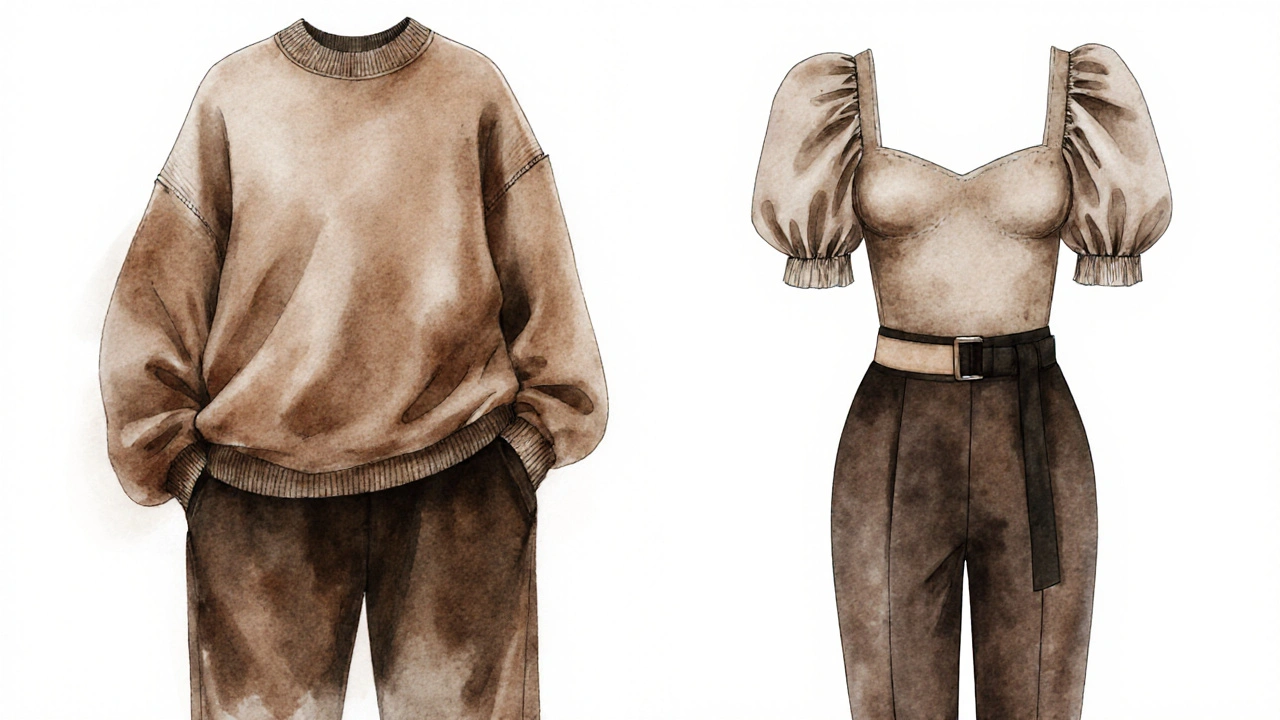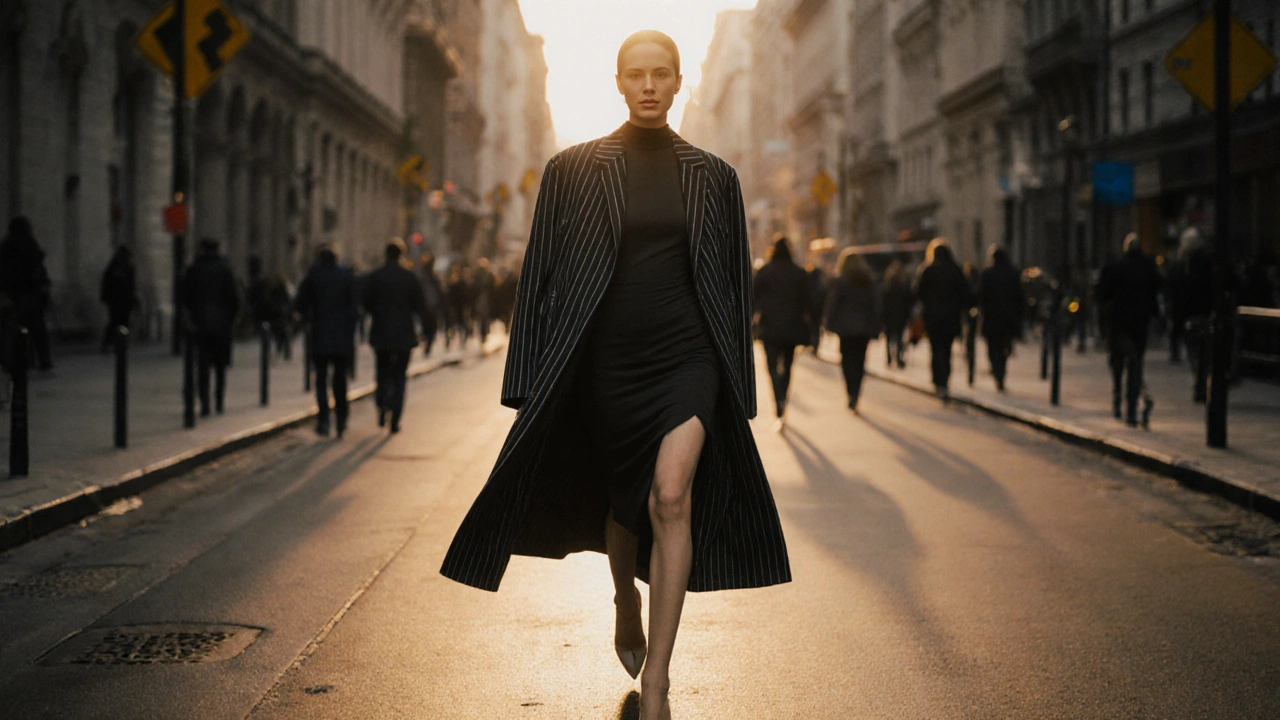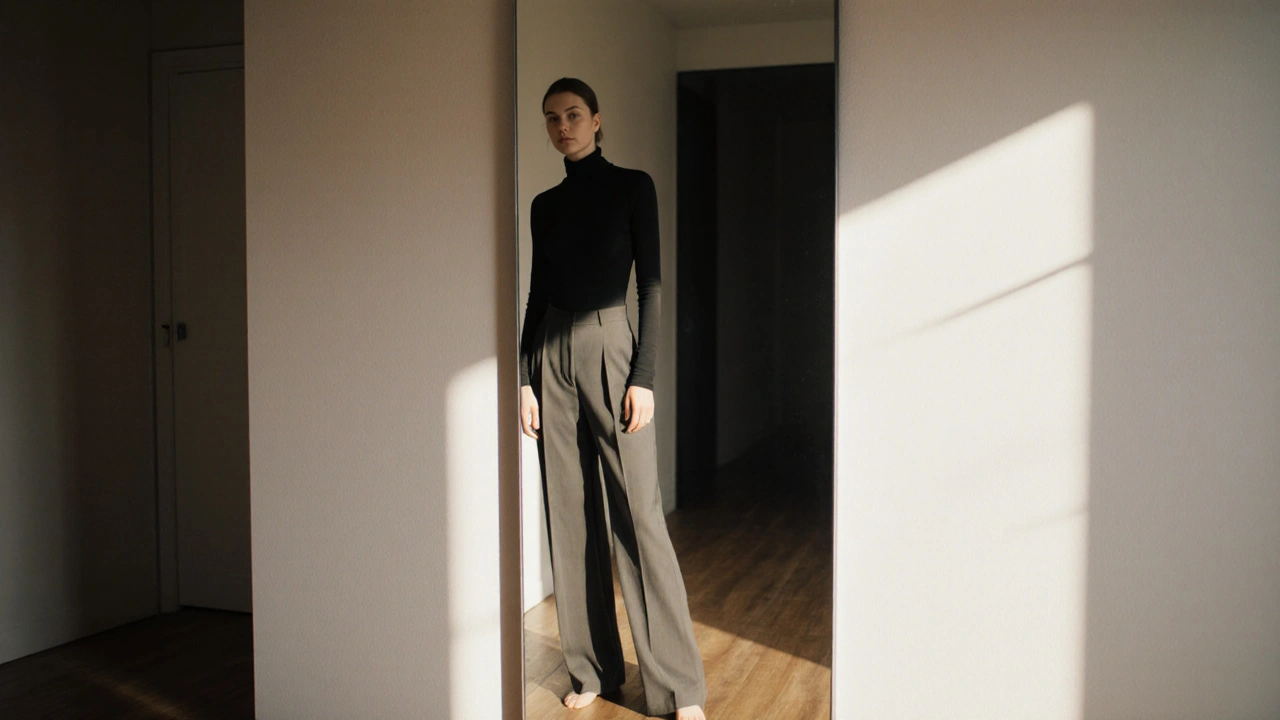Ever put on an outfit that looked great in the store, but somehow felt off when you got home? You’re not alone. The problem isn’t your body-it’s how the clothes are shaping it. Flattering proportions aren’t about hiding parts of yourself. They’re about working with your natural lines to create a look that feels intentional, balanced, and uniquely yours.
What Silhouette Really Means (And Why It Matters)
Silhouette is the outline your body makes when dressed. It’s the first thing people notice before they see fabric, color, or pattern. A defined silhouette says confidence. A messy one says confusion-even if the clothes are expensive.
Think of it like architecture. A tall, narrow building looks different from a wide, low one. The same goes for clothing. A fitted blazer with flared pants creates a strong hourglass silhouette. A boxy tunic over straight-leg jeans gives you a relaxed, modern rectangle. Neither is right or wrong. But if you want to look put-together, you need to choose the silhouette that matches your goal.
Here’s what happens when you ignore silhouette:
- You wear a voluminous top with wide-leg pants-and disappear into the fabric.
- You tuck in a bulky sweater into high-waisted jeans-and end up looking like a balloon with legs.
- You layer multiple oversized pieces-and feel like you’re wearing a tent.
Silhouette isn’t about trends. It’s about control. You’re not just wearing clothes-you’re sculpting how you appear in space.
Volume Isn’t Just About Size-It’s About Placement
People think volume means big. But volume is about adding shape where you want attention-and subtracting it where you don’t.
Take the puff sleeve. It adds volume to your shoulders and upper arms. That pulls focus upward, making your waist look smaller by contrast. That’s why puff sleeves work so well on pear-shaped bodies: they balance hips with shoulders.
On the flip side, a voluminous skirt on a full hip can overwhelm. But if you pair it with a fitted top? Suddenly, the volume becomes intentional. It’s not about avoiding volume. It’s about directing it.
Try this: Wear a structured, fitted top with a full skirt. The contrast creates visual rhythm. Your body isn’t hidden-it’s highlighted in the right places.
Volume also works in reverse. A slim-fit dress with a single dramatic detail-like a high slit or a sculpted neckline-can feel just as powerful as a full skirt. It’s about balance, not bulk.
Matching Silhouette to Body Shape (Without the Myths)
You’ve probably heard: “Pear shapes should avoid volume on the bottom.” “Apple shapes should never wear belts.” These rules are outdated-and often wrong.
Body shape guides are useful as starting points, not laws. What matters more is how you want to feel. Do you want to look taller? More powerful? More relaxed?
Here’s how real people use silhouette and volume to achieve their desired look:
- For a longer torso: Wear high-waisted pants with a tucked-in top. The line between top and bottom creates vertical flow. It doesn’t change your body-it changes how you’re seen.
- For broader shoulders: Try a V-neck dress with a slight A-line skirt. The neckline draws the eye down, and the skirt balances the upper body without adding bulk.
- For a petite frame: Avoid overwhelming volume. Instead, use small, strategic volume-like a ruffle at the cuff or a flared hem. It adds interest without swallowing your frame.
- For a curvier figure: Embrace defined waistlines. A belt, a seam, or even a contrasting color can create shape where you want it. Volume on the hips? Fine-if it’s balanced by structure on top.
The key? Don’t try to fit into a category. Use silhouette and volume to build the version of yourself you want to show up as.

The Psychology of Shape: How Clothes Influence Perception
People don’t just see your clothes-they interpret your shape. A sharp, angular silhouette reads as authoritative. A soft, flowing one reads as approachable. A balanced silhouette reads as confident.
Studies in fashion psychology show that people perceive those wearing structured, defined silhouettes as more competent-even when the outfit is identical to a looser version. That’s not magic. It’s visual signaling.
Wear a tailored coat with a defined waist? You look like someone who knows what they’re doing. Wear the same coat, but oversized and untucked? You look like you’re trying to hide.
This isn’t about conforming. It’s about communication. Your clothes are a nonverbal language. And silhouette is the grammar.
How to Test Your Silhouette Before You Buy
Here’s a simple trick: Stand in front of a full-length mirror in natural light. Put on the outfit. Now, squint your eyes.
What do you see?
If your outline is clear and intentional-you’ve got it. If everything blends into a blob-you need to adjust.
Another test: Take a photo. Then turn it black and white. Color distracts you. Shape doesn’t. If the silhouette still looks balanced without color, you’re good.
Try this with three outfits you own. One that makes you feel powerful. One that makes you feel invisible. One that makes you feel awkward. Compare them. You’ll start noticing patterns.
Don’t buy clothes based on how they look in the dressing room. Buy them based on how they shape your presence.
Real Examples: From Confusion to Clarity
Meet Maya. She’s 5’2”, with broad shoulders and a small waist. She used to wear oversized sweaters to hide her frame. Result? She looked lost in her clothes.
She switched to fitted turtlenecks with high-waisted wide-leg trousers. The top hugged her shoulders without adding bulk. The pants gave her legs length and movement. Her silhouette became a strong, clean A-shape. She started getting compliments on her “effortless style.”
Then there’s Jamal. He’s 6’1”, with a lean build. He wore slim-fit everything, thinking it made him look “sharp.” But he looked stiff. He felt like a mannequin.
He started wearing slightly relaxed button-downs, untucked, with straight-leg chinos. The extra room in the torso gave him ease. The clean lines kept him looking polished-not sloppy. His silhouette went from rigid to relaxed-and he felt more like himself.
Neither of them changed their body. They changed how they shaped their clothes around it.

Building Your Intentional Style Toolkit
You don’t need a new wardrobe. You need a new mindset.
Start with these three rules:
- One area of volume, one area of structure. If your top is puff-sleeved, keep your bottom sleek. If your skirt is full, keep your top fitted.
- Define the waist. Even if it’s just a belt, a tuck, or a seam. It anchors the whole look.
- Balance is better than symmetry. You don’t need identical volume on both sides. You need visual weight that feels fair.
Try this simple experiment this week: Pick one outfit you normally wear and tweak just one element. Swap a loose top for a fitted one. Add a belt. Roll the sleeves. See how the silhouette changes. Notice how you feel.
Style isn’t about following rules. It’s about making choices that reflect who you are-and who you want to be.
What Happens When You Get It Right
When silhouette and volume work together, something shifts. You don’t just look better. You feel different.
You walk taller. You speak louder. You stop checking yourself in mirrors. Because the clothes aren’t fighting your body anymore. They’re amplifying it.
That’s the real power of intentional styling. It doesn’t change your shape. It changes how you inhabit your body.
And that’s worth more than any trend.
Can you have flattering proportions without a defined waist?
Yes. A defined waist helps create balance, but it’s not the only way. You can use length, texture, or contrast to create visual structure. For example, a longline coat over a fitted dress creates a vertical line that draws the eye up and down, giving shape without a waistband. Or, wearing a monochrome outfit with varying textures-like a ribbed knit top and a smooth skirt-can create depth and definition without a belt or seam.
Does volume always make you look bigger?
No. Volume draws attention, but it doesn’t automatically add size. Think of it like lighting. A spotlight on your shoulders makes them look prominent, but it doesn’t make them wider. If you add volume to your upper body, it balances wider hips. If you add volume to your lower half, it can elongate your frame. The key is contrast. Volume only looks overwhelming when it’s unbalanced.
What if I like oversized clothes but still want to look intentional?
Oversized can be intentional-it just needs structure. Try pairing an oversized blazer with slim pants or a fitted turtleneck. Or wear a big sweater with high-waisted jeans and a belt. The trick is to create at least one point of definition. Without it, oversized looks like you gave up. With it, it looks like a deliberate style choice.
Do I need to follow body shape guidelines to look good?
No. Body shape guidelines are suggestions, not rules. They’re based on averages, not individuality. If you love a silhouette that’s “not recommended” for your shape, wear it. The goal isn’t to fit a category-it’s to feel confident. Use guidelines as a starting point, then experiment. What works for one person might not work for another-even if they have the same measurements.
How do I know if my silhouette looks balanced?
Stand sideways in front of a mirror. Look at your outline. Does it feel like one continuous shape? Or does it look chopped up? A balanced silhouette flows from head to toe without sudden, jarring breaks. You can also take a photo and turn it black and white. If the shape still looks intentional without color, you’ve nailed it.
Next Steps: Start Small, Think Big
You don’t need to overhaul your closet. Start with one outfit this week. Choose something you already own. Change one thing: the belt, the tuck, the sleeve length. Notice how it changes your posture, your confidence, the way people look at you.
That’s how real style happens-not in big purchases, but in small, intentional choices.


Write a comment